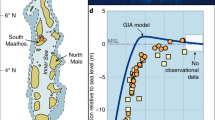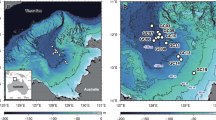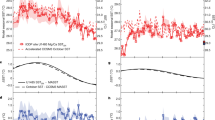Abstract
The last interglacial period, Marine Isotope Stage (MIS) 5e, was characterized by global mean surface temperatures that were at least 2 ∘C warmer than present1. Mean sea level stood 4–6 m higher than modern sea level2,3,4,5,6,7,8,9,10,11,12,13, with an important contribution from a reduction of the Greenland ice sheet1,14. Although some fossil reef data indicate sea-level fluctuations of up to 10 m around the mean3,4,5,6,7,8,9,11, so far it has not been possible to constrain the duration and rates of change of these shorter-term variations. Here, we use a combination of a continuous high-resolution sea-level record, based on the stable oxygen isotopes of planktonic foraminifera from the central Red Sea15,16,17,18, and age constraints from coral data to estimate rates of sea-level change during MIS-5e. We find average rates of sea-level rise of 1.6 m per century. As global mean temperatures during MIS-5e were comparable to projections for future climate change under the influence of anthropogenic greenhouse-gas emissions19,20, these observed rates of sea-level change inform the ongoing debate about high versus low rates of sea-level rise in the coming century21,22.
This is a preview of subscription content, access via your institution
Access options
Subscribe to this journal
Receive 12 print issues and online access
$259.00 per year
only $21.58 per issue
Buy this article
- Purchase on Springer Link
- Instant access to full article PDF
Prices may be subject to local taxes which are calculated during checkout


Similar content being viewed by others
References
Otto-Bliesner, B. L. et al. Simulating Arctic climate warmth and icefield retreat in the last interglaciation. Science 311, 1751–1753 (2006).
McCulloch, M. T. & Esat, T. The coral record of last interglacial sea levels and sea surface temperatures. Chem. Geol. 169, 107–129 (2000).
Stirling, C. H., Esat, T. M., Lambeck, K. & McCulloch, M. T. Timing and duration of the Last Interglacial: Evidence for a restricted interval of widespread coral reef growth. Earth Planet. Sci. Lett. 160, 745–762 (1998).
Thompson, W. G. & Goldstein, S. L. Open-system coral ages reveal persistent suborbital sea-level cycles. Science 308, 401–404 (2005).
Plaziat, J. C. et al. Mise en evidence, sur la côte récifale d’Egypte, d’une régression interrompant le plus haut niveau du Dernier Interglaciaire (5e): Un nouvel indice de variations glacio-eustatiques haute fréquence au Pléistocène? Bull. Soc. Geol. Fr. 169, 115–125 (1998).
Plaziat, J. C. et al. Quaternary changes in the Egyptian shoreline of the northwestern Red Sea and Gulf of Suez. Quat. Internat. 29/30, 11–22 (1995).
Orszag-Sperber, F., Plaziat, J. C., Baltzer, F. & Purser, B. H. Gypsum salina-coral reef relationships during the Last Interglacial (Marine Isotopic Stage 5e) on the Egyptian Red Sea coast: A Quaternary analogue for Neogene marginal evaporites? Sedim. Geol. 140, 61–85 (2001).
Neumann, A. C. & Hearty, P. J. Rapid sea-level changes at the close of the last interglacial (substage 5e) recorded in Bahamian island geology. Geology 24, 775–778 (1996).
Chen, J. H., Curran, H. A., White, R. & Wasserburg, G. J. Precise chronology of the last interglacial period: 234U–230Th data from fossil coral reefs in the Bahamas. Geol. Soc. Am. Bull. 103, 82–97 (1991).
El-Asmar, H. M. Quaternary isotope stratigraphy and paleoclimate of coral reef terraces, Gulf of Aqaba, South Sinai, Egypt. Quat. Sci. Rev. 16, 911–924 (1997).
Bruggemann, J. H. et al. Stratigraphy, palaeoenvironments and model for the deposition of the Abdur Reef Limestone: Context for an important archaeological site from the last interglacial on the Red Sea coast of Eritrea. Palaeogeogr. Palaeoclimatol. Palaeoecol. 203, 179–206 (2004).
Walter, R. C. et al. Early human occupation of the Red Sea coast of Eritrea during the last interglacial. Nature 405, 65–69 (2000).
Stirling, C. H., Esat, T. M., McCulloch, M. T. & Lambeck, K. High-precision U-series dating of corals from Western Australia and implications for the timing and duration of the Last Interglacial. Earth Planet. Sci. Lett. 135, 115–130 (1995).
Cuffey, K. M. & Marshall, S. J. Substantial contribution to sea-level rise during the last interglacial from the Greenland ice sheet. Nature 404, 591–594 (2000).
Siddall, M., Bard, E., Rohling, E. J. & Hemleben, Ch. Sea-level reversal during Termination II. Geology 34, 817–820 (2006).
Arz, H. W. et al. Dominant Northern Hemisphere climate control over millennial-scale glacial sea-level variability. Quat. Sci. Rev. 26, 312–321 (2007).
Siddall, M. et al. Sea-level fluctuations during the last glacial cycle. Nature 423, 853–858 (2003).
Siddall, M. et al. Understanding the Red Sea response to sea level. Earth Planet. Sci. Lett. 225, 421–434 (2004).
Folland, C. K. et al. in Climate Change 2001, The Scientific Basis. Contribution of Working Group I to the Third Assessment Report of the Intergovernmental Panel on Climate Change (ed. Houghton, J. T. et al.) 99–181 (Cambridge Univ. Press, Cambridge and New York, 2001).
Gregory, J. M., Huybrechts, P. & Raper, S. C. B. Threatened loss of the Greenland ice sheet. Nature 428, 616 (2004).
Rahmstorf, S. A semi-empirical approach to projecting future sea-level rise. Science 315, 368–370 (2007).
Church, J. M. et al. in Climate Change 2001, The Scientific Basis. Contribution of Working Group I to the Third Assessment Report of the Intergovernmental Panel on Climate Change (ed. Houghton, J. T. et al.) 639–693 (Cambridge Univ. Press, Cambridge and New York, 2001).
Fairbanks, R. G. A 17,000-year glacio-eustatic sea level record: Influence of glacial melting rates on the Younger Dryas event and deep-ocean circulation. Nature 342, 637–642 (1989).
Blanchon, P. & Shaw, J. Reef drowning during the last deglaciation: Evidence for catastrophic sea-level rise and ice-sheet collapse. Geology 23, 4–8 (1995).
Stanford, J. D. et al. Timing of meltwater pulse 1a and climate responses to meltwater injections. Paleoceanography 21, PA4103 (2006).
Cazenave, A. How fast are the ice sheets melting? Science 314, 1250–1252 (2006).
Hemleben, Ch. et al. Three hundred and eighty thousand year-long stable isotope and faunal records from the Red Sea. Paleoceanography 11, 147–156 (1996).
Schellmann, G. & Radtke, U. A revised morpho- and chronostratigraphy of the late and middle Pleistocene coral reef terraces on Southern Barbados (West Indies). Earth Sci. Rev. 64, 157–187 (2004).
Scholz, A., Mangini, A. & Felis, T. U-series dating of diagenetically altered fossil reef corals. Earth Planet. Sci. Lett. 218, 163–178 (2004).
Hearty, P. J., Neumann, A. C. & O’Leary, M. J. Comment on ‘Record of MIS5 sea-level highstands based on U/Th dated coral terraces of Haiti’ by Dumas et al. [Quaternary International 2006 106–118]. Quat. Internat. 162/163, 205–208 (2007).
Rohling, E. J. et al. African monsoon variability during the previous interglacial maximum. Earth Planet. Sci. Lett. 202, 61–75 (2002).
Acknowledgements
We thank all colleagues who have offered advice that helped shape the arguments in this manuscript, I. Schmeltzer, S. Geiselhart and H. Erlenkeuser for work on core KL11, and G. Trommer and M. Siccha for work on KL09. H. Elderfield provided valuable feedback to the Mg/Ca pilot study, and I. Marshall and C. Hayward helped with scanning electron microscope and electron microprobe analyses. This study was supported by the UK Natural Environment Research Council (NERC, NE/C003152/1), the German Science Foundation (DFG, He 697/17; Ku 2259/3) and EC project STOPFEN (HPRN-CT-2002-00221).
Author information
Authors and Affiliations
Corresponding authors
Supplementary information
Supplementary Information
Supplementary table S1 and supplementary figures S1, S2 and S3 (PDF 939 kb)
Rights and permissions
About this article
Cite this article
Rohling, E., Grant, K., Hemleben, C. et al. High rates of sea-level rise during the last interglacial period. Nature Geosci 1, 38–42 (2008). https://doi.org/10.1038/ngeo.2007.28
Received:
Accepted:
Published:
Issue Date:
DOI: https://doi.org/10.1038/ngeo.2007.28
This article is cited by
-
Whole-genome resequencing provides insights into the population structure and domestication signatures of ducks in eastern China
BMC Genomics (2021)
-
No detectable Weddell Sea Antarctic Bottom Water export during the Last and Penultimate Glacial Maximum
Nature Communications (2020)
-
Potential impact of sea level rise on the geomorphology of Kuwait state coastline
Arabian Journal of Geosciences (2020)
-
Asynchronous Antarctic and Greenland ice-volume contributions to the last interglacial sea-level highstand
Nature Communications (2019)
-
Facies Analysis and Sequence Stratigraphy of Al-Kharrar Lagoon Coastal Sediments, Rabigh Area, Saudi Arabia: Impact of Sea-Level and Climate Changes on Coastal Evolution
Arabian Journal for Science and Engineering (2019)



